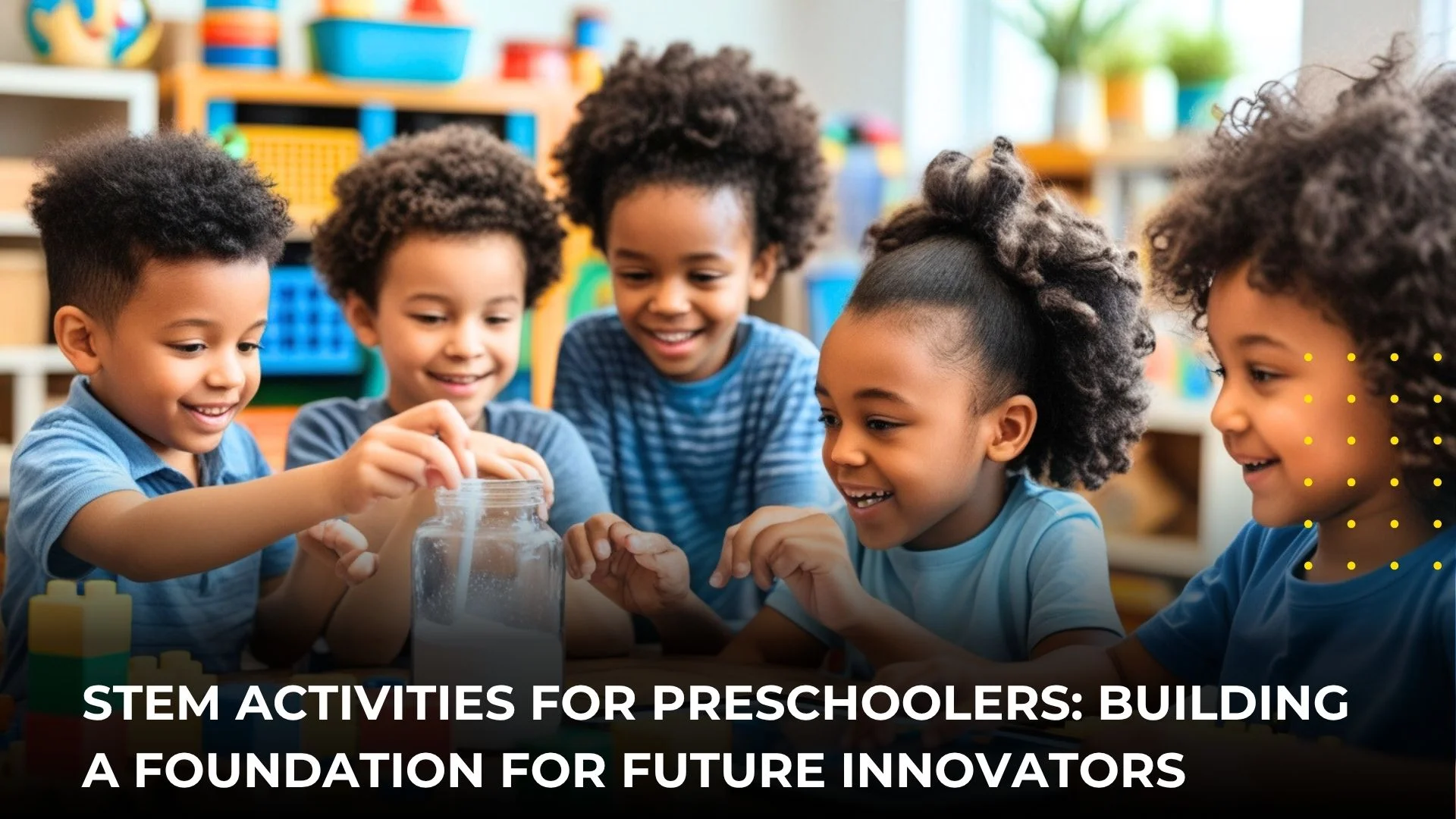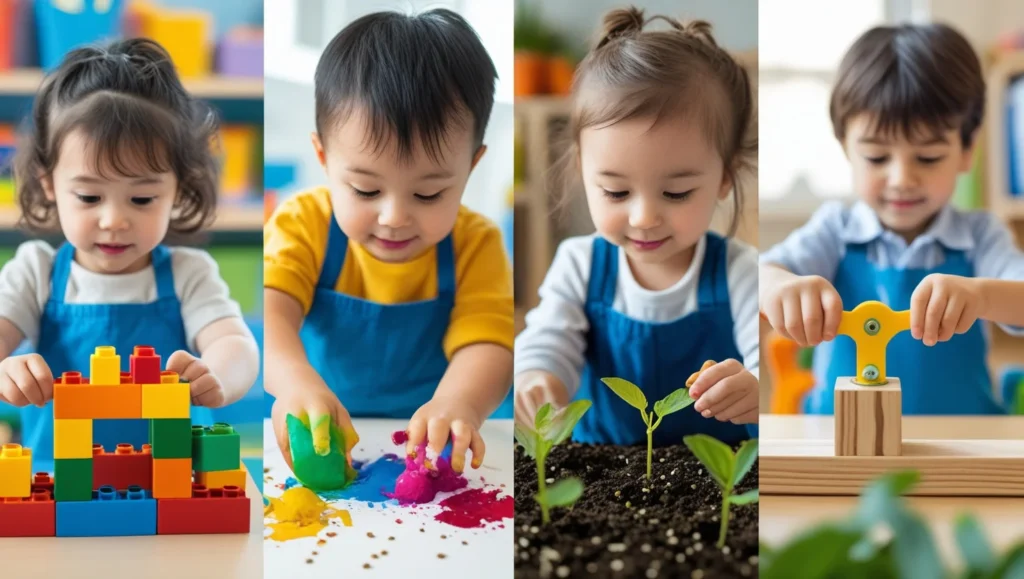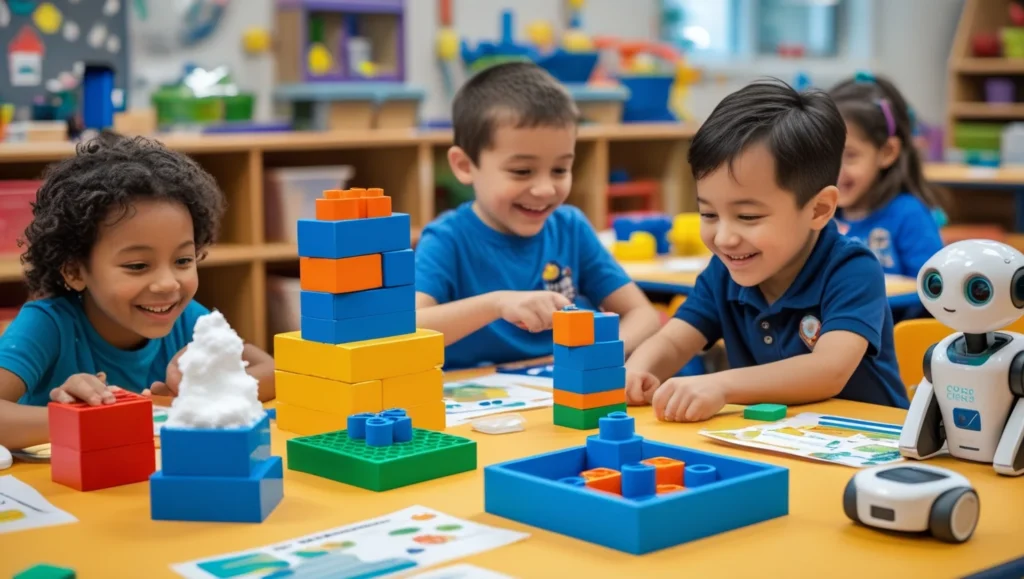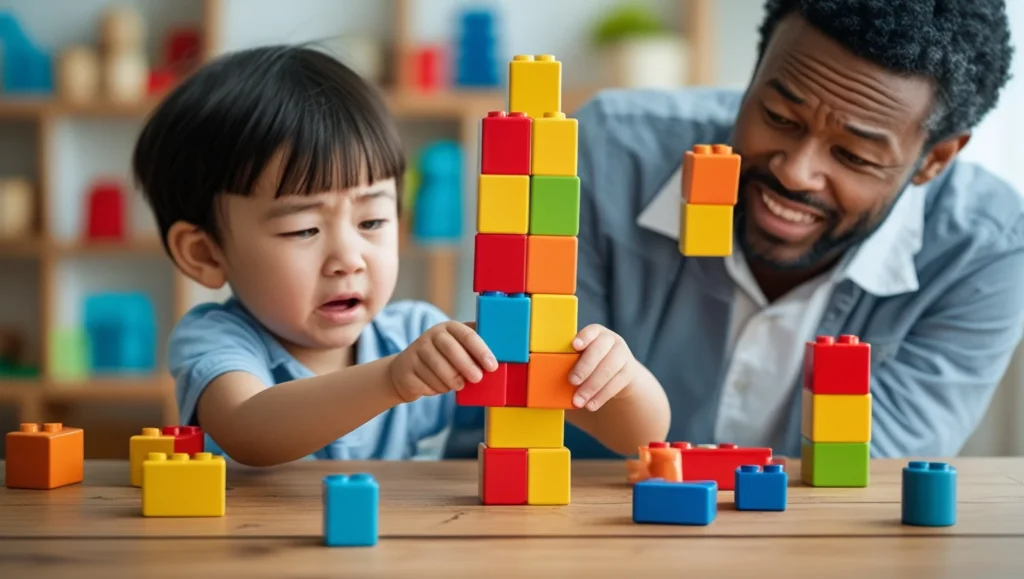Currently Empty: ₹0.00
Blog
4 Amazing STEM Activities for Preschoolers to Inspire Wonder

Key Takeaways:
- STEM activities for preschoolers spark curiosity and build foundational skills in science, technology, engineering, and math through play-based learning.
- Simple, age-appropriate experiments like sink-or-float tests or building block towers engage young minds and encourage critical thinking.
- Incorporating everyday materials, such as paper cups or baking soda, makes STEM accessible and budget-friendly for parents and educators.
- Parental involvement and storytelling enhance the learning experience, fostering creativity and problem-solving in preschoolers.
- Consistent STEM exposure helps children develop confidence and prepares them for future academic success.
Why STEM Activities for Preschoolers Matter
Picture a four-year-old carefully placing a feather in a tub of water, eyes wide with wonder as it floats, or a three-year-old stacking blocks to build a tower that teeters but stands tall. These moments of play are more than just fun—they’re the first steps toward scientific discovery. STEM activities for preschoolers (Science, Technology, Engineering, and Math) transform everyday play into opportunities for learning, igniting curiosity and laying the groundwork for critical thinking.
Research suggests that early exposure to STEM fosters problem-solving skills, boosts confidence, and prepares children for a world driven by innovation. For instance, the Early Learning STEM Australia (ELSA) project, a national study in Australia, has shown that four-year-olds are capable of sophisticated STEM thinking, such as creating detailed maps and replicating complex models typically associated with older children (ELSA Project).
Why start so young? Young children are natural scientists—curious, eager to experiment, and unafraid to fail. By introducing STEM through hands-on, play-based activities, parents and educators can nurture a love for learning that lasts a lifetime. This article explores engaging, budget-friendly STEM activities for preschoolers, complete with step-by-step guides, real-world examples, and tips to make learning unforgettable.
What Makes a Great STEM Activity for Preschoolers?

Preschool STEM activities that work are easy, interesting, and meant to pique children’s interest. According to experts, the best activities share these characteristics:
- Hands-On Engagement: Preschoolers learn by doing. Activities involving touching, building, or mixing keep them captivated.
- Age-Appropriate Challenges: Tasks should be manageable for small hands but challenging enough to encourage exploration.
- Open-Ended Exploration: Activities with no single “right” answer foster creativity and problem-solving.
- Real-Life Connections: Linking activities to everyday experiences, like cooking or gardening, makes STEM relatable.
These principles guide the activities below, ensuring they’re both fun and educational.
Top STEM Activities for Preschoolers to Try Today
1. Sink or Float Experiment
Why It Works: This classic science experiment introduces preschoolers to buoyancy while encouraging them to make predictions and observe outcomes.
What You’ll Need:
- A large bowl or tub of water
- Everyday objects (e.g., spoon, feather, toy car, cork, plastic cup)
- A notebook or chart for recording predictions
How to Do It:
- Fill the tub with water and gather your objects.
- Invite your child to make a guess before dropping each item into the water—say something like, “Do you think the spoon will float on the surface or sink to the bottom?”
- One by one, submerge each object in the water and watch what occurs.
- Discuss the results. Why did the feather float? Why did the spoon sink?
Learning Moment: Encourage noticing patterns, such as lightweight objects floating and heavier ones sinking, introducing basic density concepts in a simple way.
Real-World Connection: Share a story about boats or icebergs. For example, “Boats float like the cork because they’re designed to push water away!” You can also show a kid-friendly video about buoyancy from National Geographic Kids.
2. Build a Block Tower Challenge
Why It Works: Building with blocks teaches students engineering concepts like balance and stability while fostering problem-solving.
What You’ll Need:
- Wooden or plastic building blocks
- A flat surface
- Optional: a ruler or measuring tape
How to Do It:
- Give your preschooler the task of constructing the tallest structure they can without it collapsing.
- Let them experiment with different block arrangements, such as stacking vertically or creating a wider base.
- If the tower falls, ask, “What could we do differently to make it stronger?”
- Measure the height of the final tower to add a math component.
Learning Moment: Discuss why a wider base improves stability, introducing terms like “balance” or “foundation” to build engineering vocabulary.
Real-World Connection: Point out buildings or bridges in your neighborhood. Ask, “How do engineers make tall buildings stay up?” For inspiration, visit PBS Kids for engineering activity ideas.

3. Baking Soda and Vinegar Volcano
Why It Works: This fizzy experiment teaches chemical reactions in a visually exciting way, captivating young learners.
What You’ll Need:
- Baking soda
- Vinegar
- Food coloring (optional)
- A small container (e.g., plastic cup)
- A tray to catch the mess
How to Do It:
- Place the container on the tray and add a few tablespoons of baking soda.
- Add a drop of food coloring for extra fun.
- Pour vinegar into the container and watch the “volcano” erupt!
- Ask your child to describe what they see and why it’s bubbling.
Learning Moment: Explain that the fizzing occurs because baking soda and vinegar react to create carbon dioxide gas. Simplify it: “It’s like the bubbles in soda!”
Real-World Connection: Discuss real volcanoes or show a short, kid-friendly video about eruptions from National Geographic Kids.
4. Nature Scavenger Hunt
Why It Works: A scavenger hunt encourages observation and classification, key skills in science and math.
What You’ll Need:
- A backyard or park
- Something to look for, like a leaf, a pebble, something smooth, or something green
- A bag or basket for collecting
How to Do It:
- Create a simple list of items for your child to find. For non-readers, use pictures or describe the items.
- Go on a walk and encourage them to collect items that match the list.
- Back home, sort the items by color, size, or texture.
- Ask questions like, “Why do you think leaves are different shapes?”
Learning Moment: Sorting introduces math concepts like categorization and comparison, while encouraging curiosity about the natural world.
Real-World Connection: Explain how scientists study plants and animals, just like your child is observing nature. Resources from Science Buddies offer more nature-based activities.
Incorporating Technology into STEM Activities for Preschoolers
Technology is a vital part of STEM, and even preschoolers can benefit from age-appropriate tech tools that make learning interactive. While concerns about screen time are valid, experts suggest that mindful use of technology can enhance engagement and prepare children for a digital world (American University). Here are a few STEM activities for toddlers that involve technology:
- Coding with Bee-Bot: Bee-Bot is a programmable robot that children can direct to move forward, backward, left, or right. By programming Bee-Bot to navigate a map or complete a task, preschoolers learn sequencing and basic coding concepts (Aussie Kindies).
- Hands-On Coding Fun with Code-a-Pillar: The Fisher-Price Code-a-Pillar introduces young minds to the foundations of coding by allowing them to connect movable segments that guide the toy’s actions. This interactive experience nurtures problem-solving and sequencing skills in a creative, screen-free way (Rasmussen University).
- Interactive Learning Apps: Apps like Endless Alphabet teach letters through puzzles, while Tynker offers coding games that are fun and educational (SplashLearn).
- Digital Storytelling: Using tablets, children can create stories with photos or drawings, incorporating STEM elements like patterns or shapes.
- Educational Videos: Channels like PBS Kids and National Geographic Kids offer engaging content to spark STEM interest.
Tips for Using Technology:
- Choose age-appropriate tools and content.
- Supervise and guide children during tech use.
- Limit screen time to balance with hands-on activities.
- Use technology to enhance, not replace, exploration.
Tips for Making STEM Activities Fun and Effective
- Involve Storytelling: Weaving narratives into STEM activities makes them memorable. Take, for example, a sink-or-float experiment in which you are pirates inspecting riches. This engages imagination and reinforces concepts.
- Encourage Questions: Let children’s questions guide activities. If they ask, “Why does the balloon float?” explain gases simply. This fosters a growth mindset, showing questions lead to discoveries.
- Keep It Safe and Simple: Use non-toxic household items and avoid choking hazards. Supervise experiments involving water or chemicals like vinegar.
- Celebrate Mistakes: STEM thrives on trial and error. If a tower falls, ask, “What can we try next?” This builds resilience and problem-solving skills.
How Parents and Educators Can Support STEM Learning
Parents and educators play a crucial role in fostering STEM interest. For example, during a family activity, I built a popsicle stick bridge with my preschooler to help her toy animals cross a “river” (a blue towel). When it collapsed, she laughed and tried again, showing the joy of learning through failure. Educators can integrate STEM into daily routines, like counting toys during circle time. Dr. Karen Worth, an early childhood expert, notes, “STEM in preschool isn’t about formal lessons—it’s about creating opportunities for children to explore and ask questions” (NAEYC).

Creating a STEM-Friendly Environment
- Set Up a STEM Corner: Dedicate a space with blocks, magnifying glasses, or recycled materials.
- Use Everyday Moments: Cooking teaches measurement; bath time explores floating and sinking.
- Celebrate Curiosity: Praise children for asking “why” or trying new things.
Why Early STEM Exposure Matters
Early STEM exposure has lasting benefits. The ELSA project found that four-year-olds engaging in STEM activities develop advanced cognitive skills, like map-making, which predict later academic success (First Five Years). Children exposed to STEM are also more likely to pursue STEM-related interests later (Yuma Preschool). For example, Emily, a four-year-old who loved mixing colors, later explored optics and built a prism by age six, showing how early STEM sparks lifelong curiosity.
Overcoming Common Challenges
- Short Attention Spans: Keep activities short (10–15 minutes) and switch if interest fades.
- Messy Experiments: Use trays or do activities outside to simplify cleanup.
- Lack of Resources: Use everyday items like cardboard or string (Taming Little Monsters).

Resources for More STEM Fun
Explore trusted resources like:
- PBS Kids: Free STEM activity guides.
- National Geographic Kids: Simple science experiments.
- Science Buddies: Hands-on STEM projects.
Local STEM workshops or science museums also offer preschool-friendly exhibits.
Conclusion
Preschool STEM activities are a springboard for exploration rather than just play. By engaging young children in hands-on, play-based learning that integrates science, technology, engineering, and math, we nurture curiosity, creativity, and problem-solving skills. Whether it’s a fizzy volcano, a block tower, or a coding adventure with Bee-Bot, each activity plants a seed of wonder. Let’s embrace the joy of STEM and watch our preschoolers grow into confident thinkers ready for tomorrow’s challenges.



